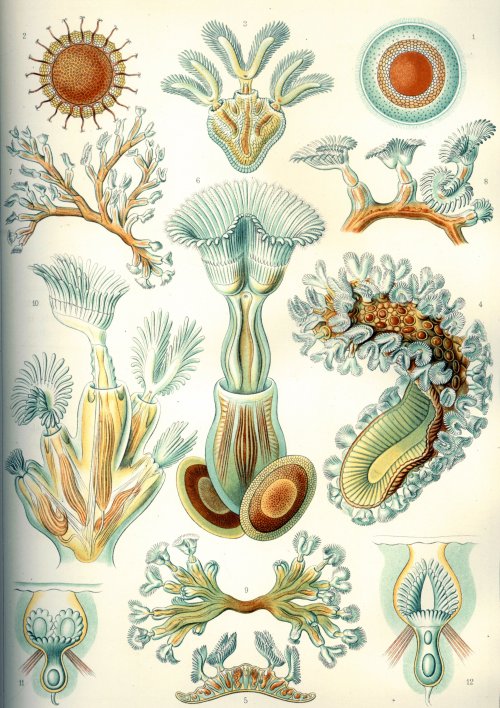Stuff In My Office

Stuff in My Office
Dr Warhol’s Periodic Table of Microbes
From: Ernst Haeckel’s book Kunstformen der Natur (1904). This illustration is plate 23 the Bryozoa.
More Posts from Hannahhaifisch and Others

the most hypnotic thing you´ll see today.

Modular Origami Star by Maria Sinayskaya http://flic.kr/p/dJtry6

Geometric Animations / 170402

Photograph of the May 1919 solar eclipse captured by Arthur Eddington, which proved Einstein’s theory of general relativity.
Credit: SSPL/Getty Images

Native Gold with White Quartz
Eagle’s Nest Mine, Placer County, California

325 Triangles

Robert Irwin @ Art Basel 2015
Black 3, 2008
via

Scientists discover a 2-D magnet
Magnetic materials form the basis of technologies that play increasingly pivotal roles in our lives today, including sensing and hard-disk data storage. But as our innovative dreams conjure wishes for ever-smaller and faster devices, researchers are seeking new magnetic materials that are more compact, more efficient and can be controlled using precise, reliable methods.
A team led by the University of Washington and the Massachusetts Institute of Technology has for the first time discovered magnetism in the 2-D world of monolayers, or materials that are formed by a single atomic layer. The findings, published June 8 in the journal Nature, demonstrate that magnetic properties can exist even in the 2-D realm – opening a world of potential applications.
“What we have discovered here is an isolated 2-D material with intrinsic magnetism, and the magnetism in the system is highly robust,” said Xiaodong Xu, a UW professor of physics and of materials science and engineering, and member of the UW’s Clean Energy Institute. “We envision that new information technologies may emerge based on these new 2-D magnets.”
Xu and MIT physics professor Pablo Jarillo-Herrero led the international team of scientists who proved that the material – chromium triiodide, or CrI3 – has magnetic properties in its monolayer form.
Read more.


Beautiful Geometric Skeletons of Ancient Jellyfish Fossils
The 520-million-year-old fossils reveal that ancient comb jellies had stunning geometric skeletons that have disappeared over the course of evolution, researchers report in a paper published in the journal Science Advances. These strange skeletons contained eight rigid plates that surrounded the jellies’ organs and eight spoke-like structures that radiated outward to surround the soft lobes of their bodies.
The unusual symmetry of these skeletons makes them aesthetically appealing, but it also likely provided mechanical support for the jellies’ squishy bodies. It may have aided in defense against predators or other dangers as well, the researchers suggest.
entire article on techtimes
-
 kunstschutz reblogged this · 4 years ago
kunstschutz reblogged this · 4 years ago -
 kunstschutz liked this · 4 years ago
kunstschutz liked this · 4 years ago -
 aegeus-greekaegeansevresjuly1920 reblogged this · 6 years ago
aegeus-greekaegeansevresjuly1920 reblogged this · 6 years ago -
 aegeus-greekaegeansevresjuly1920 liked this · 6 years ago
aegeus-greekaegeansevresjuly1920 liked this · 6 years ago -
 glumshoe liked this · 6 years ago
glumshoe liked this · 6 years ago -
 damnedlittledame reblogged this · 7 years ago
damnedlittledame reblogged this · 7 years ago -
 asnailbutgay liked this · 7 years ago
asnailbutgay liked this · 7 years ago -
 azagora reblogged this · 7 years ago
azagora reblogged this · 7 years ago -
 happimon liked this · 7 years ago
happimon liked this · 7 years ago -
 windydesert reblogged this · 7 years ago
windydesert reblogged this · 7 years ago -
 undmeinkleinesherzbounct liked this · 7 years ago
undmeinkleinesherzbounct liked this · 7 years ago -
 guerraenlaluna liked this · 7 years ago
guerraenlaluna liked this · 7 years ago -
 vividblues liked this · 7 years ago
vividblues liked this · 7 years ago -
 brilmans liked this · 7 years ago
brilmans liked this · 7 years ago -
 greeant reblogged this · 7 years ago
greeant reblogged this · 7 years ago -
 pithepie reblogged this · 8 years ago
pithepie reblogged this · 8 years ago -
 ancastoica reblogged this · 8 years ago
ancastoica reblogged this · 8 years ago -
 itiruk reblogged this · 8 years ago
itiruk reblogged this · 8 years ago -
 groundwater reblogged this · 8 years ago
groundwater reblogged this · 8 years ago -
 iamdaylight reblogged this · 8 years ago
iamdaylight reblogged this · 8 years ago -
 synairesis liked this · 8 years ago
synairesis liked this · 8 years ago -
 tenaciouspeacestudent liked this · 8 years ago
tenaciouspeacestudent liked this · 8 years ago -
 danae-b liked this · 8 years ago
danae-b liked this · 8 years ago -
 ifearnofish reblogged this · 8 years ago
ifearnofish reblogged this · 8 years ago -
 youvegotaluckyface reblogged this · 8 years ago
youvegotaluckyface reblogged this · 8 years ago -
 nangoat reblogged this · 8 years ago
nangoat reblogged this · 8 years ago -
 captaintinypoofypirate liked this · 8 years ago
captaintinypoofypirate liked this · 8 years ago -
 bbyoungg liked this · 8 years ago
bbyoungg liked this · 8 years ago -
 invertpaleo-blog reblogged this · 8 years ago
invertpaleo-blog reblogged this · 8 years ago -
 coiponds liked this · 8 years ago
coiponds liked this · 8 years ago -
 tea-adventures reblogged this · 8 years ago
tea-adventures reblogged this · 8 years ago -
 jewjewchrist liked this · 8 years ago
jewjewchrist liked this · 8 years ago -
 timothea reblogged this · 8 years ago
timothea reblogged this · 8 years ago -
 alitaplateadasposts-blog liked this · 8 years ago
alitaplateadasposts-blog liked this · 8 years ago -
 pliocenecat liked this · 8 years ago
pliocenecat liked this · 8 years ago -
 hellopluisje reblogged this · 8 years ago
hellopluisje reblogged this · 8 years ago -
 redhousehead liked this · 8 years ago
redhousehead liked this · 8 years ago -
 reflauta reblogged this · 8 years ago
reflauta reblogged this · 8 years ago -
 wolpaw reblogged this · 8 years ago
wolpaw reblogged this · 8 years ago -
 ghostly2lighten liked this · 8 years ago
ghostly2lighten liked this · 8 years ago -
 lappeux liked this · 8 years ago
lappeux liked this · 8 years ago -
 rquijano reblogged this · 8 years ago
rquijano reblogged this · 8 years ago -
 levogiro liked this · 8 years ago
levogiro liked this · 8 years ago -
 miasimia reblogged this · 8 years ago
miasimia reblogged this · 8 years ago -
 koukoupepia liked this · 8 years ago
koukoupepia liked this · 8 years ago -
 atomic-apricot liked this · 8 years ago
atomic-apricot liked this · 8 years ago